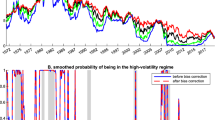Abstract
In this paper, we extend the one-factor, single regime shift, affine term structure model with time-dependent regime-shift probability to a multi-factor model. We model the nominal interest rate and the expected inflation rate, and estimate the term structure of the real interest rate in the Japanese government bond market using inflation-indexed bond data under zero interest rates. Incorporating the economic structure that the Bank of Japan terminates the zero interest rate when the expected inflation rate gets out of deflationary regime, we estimate the yield curve of the real interest rate for less than 10 years, consistent with the expectation of the market participants in the Japanese government bond market, where inflation-indexed bonds are traded for only around 10 years.
Similar content being viewed by others
References
Ang A., Bekaert G., Wei M. (2007) The term structure of real rates and expected inflation. Journal of Finance 3: 797–849
Baba N., Nishioka S., Oda N., Shirakawa M., Ueda K., Ugai H. (2005) Japan’ s deflation, problems in the financial system, and monetary policy. Monetary and Economic Studies 23(1): 47–111
Bansal R., Zhou H. (2002) Term structure of interest rates with regime shifts. Journal of Finance 57(5): 1997–2043
Bernanke B., Reinhart V., Sack B. (2005) Monetary policy alternative at the zero bound: An empirical assessment. Brookings Papers on Economic Activity 2: 1–78
Bielecki T. R., Rutkowski M. (2002) Credit risk: Modeling, valuation and hedging. Springer, Berlin
Black F. (1995) Interest rates as options. Journal of Finance 50(5): 1371–1376
Cox J., Ingersoll J. Jr., Ross S. (1985) A theory of the term structure of interest rates. Econometrica 53(2): 385–407
Dai Q., Singleton K. (2000) Specification analysis of affine term structure models. Journal of Finance 55(5): 1943–1978
Dai Q., Singleton K. (2003) Term structure dynamics in theory and reality. Review of Financial Studies 16(3): 631–678
Dai Q., Singleton K., Yang W. (2007) Regime shifts in a dynamic term structure model of US treasury bond yields. Review of Financial Studies 20: 1669–1706
Duffee G. (2002) Term premia and interest rate forecasts in affine models. Journal of Finance 57(1): 405–443
Duffie D., Kan R. (1996) A yield-factor model of interest rates. Mathematical Finance 6(4): 379–406
Fujitake, H. (2005). An extension of the CIR model with structural change (in Japanese). Master’s thesis, Hitotsubashi University.
Fujiwara S. (2008) Recent yield curve models aiming for better fitting in low interest environment (in Japanese). Kinyu Kenkyu 27(1): 93–112
Gorovoi V., Linetsky V. (2004) Black’s model of interest rates as options, eigenfunction expansions and Japanese interest rates. Mathematical Finance 14(1): 49–78
Hansen A., Poulsen R. (2000) A simple regime switching term structure model. Finance and Stochastics 4(4): 409–429
Heath D., Jarrow R., Morton A. (1992) Bond pricing and the term structure of interest rate: A new methodology for contingent claims valuation. Econometrica 60(1): 77–105
Ichiue, H., & Ueno, Y. (2006). Monetary policy and the yield curve at zero interest: The macro-finance model of interest rates as option. Bank of Japan Working Paper Series No. 06-E-16.
Jarrow R., Yildirim Y. (2003) Pricing treasury inflation protected securities and related derivatives using an HJM model. Journal of Financial and Quantitative Analysis 38(2): 337–358
Kabanov Y., Kijima M., Rinaz S. (2007) A positive interest rate model with sticky barrier. Quantitative Finance 7(3): 269–284
Landen C. (2000) Bond pricing in a hidden markov model of the short rate. Finance and Stochastics 4(4): 371–389
Marumo, K., Nakayama, T., Nishioka, S., & Yoshida, T. (2003). Extracting market expectations on the duration of the zero interest rate policy from Japan’s bond prices. Financial Markets Department Working Paper 03-E-2, Bank of Japan.
Sangvinatsos A., Wachter J. A. (2005) Does the failure of the expectations hypothesis matter for long-term investors?. Journal of Finance 60(1): 179–230
Ueno, Y., Baba, N., & Sakurai, Y. (2006). The use of the Black model of interest rates as options for monitoring the JGB market expectations. Bank of Japan Working Paper Series No. 06-E-15.
Vasicek O. (1977) An equilibrium characterization of the term structure. Journal of Financial Economics 5(2): 177–188
Wu S., Zeng Y. (2005) A general equilibrium model of the term structure of interest rates under regime-switching risk. International Journal of Theoretical and Applied Finance 8(7): 839–869
Author information
Authors and Affiliations
Corresponding author
Rights and permissions
About this article
Cite this article
Futami, H. Multi-factor Affine Term Structure Model with Single Regime Shift: Real Term Structure under Zero Interest Rate. Asia-Pac Financ Markets 16, 347–369 (2009). https://doi.org/10.1007/s10690-009-9098-0
Received:
Accepted:
Published:
Issue Date:
DOI: https://doi.org/10.1007/s10690-009-9098-0




